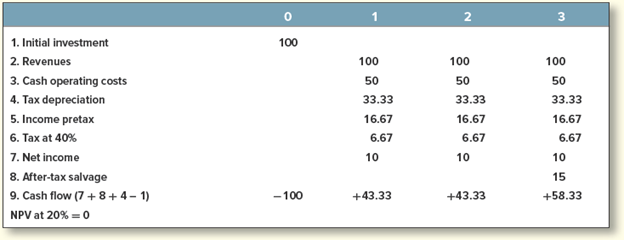Taxes are costs, and, therefore, changes in tax rates can affect consumer prices, project lives, and the value of existing firms. Evaluate the change in taxation on the valuation of the following project: Please find the project in the image attached to this question. Thank you Assumptions: Tax depreciation is straight-line over three years. Pre-tax salvage value is 25 in Year 3 and 50 if the asset is scrapped in Year 2. Tax on salvage value is 40% of the difference between salvage value and book value of the investment. The cost of capital is 20%. Please verify that the information above yields NPV = 0. If you decide to terminate the project in Year 2, what would be the NPV of the project? Suppose that the government now changes tax depreciation to allow a 100% write-off in Year 1. How does this affect your answers to parts a and b above? please explain in detail your Excel spreadsheet response.
Net Present Value
Net present value is the most important concept of finance. It is used to evaluate the investment and financing decisions that involve cash flows occurring over multiple periods. The difference between the present value of cash inflow and cash outflow is termed as net present value (NPV). It is used for capital budgeting and investment planning. It is also used to compare similar investment alternatives.
Investment Decision
The term investment refers to allocating money with the intention of getting positive returns in the future period. For example, an asset would be acquired with the motive of generating income by selling the asset when there is a price increase.
Factors That Complicate Capital Investment Analysis
Capital investment analysis is a way of the budgeting process that companies and the government use to evaluate the profitability of the investment that has been done for the long term. This can include the evaluation of fixed assets such as machinery, equipment, etc.
Capital Budgeting
Capital budgeting is a decision-making process whereby long-term investments is evaluated and selected based on whether such investment is worth pursuing in future or not. It plays an important role in financial decision-making as it impacts the profitability of the business in the long term. The benefits of capital budgeting may be in the form of increased revenue or reduction in cost. The capital budgeting decisions include replacing or rebuilding of the fixed assets, addition of an asset. These long-term investment decisions involve a large number of funds and are irreversible because the market for the second-hand asset may be difficult to find and will have an effect over long-time spam. A right decision can yield favorable returns on the other hand a wrong decision may have an effect on the sustainability of the firm. Capital budgeting helps businesses to understand risks that are involved in undertaking capital investment. It also enables them to choose the option which generates the best return by applying the various capital budgeting techniques.
Taxes are costs, and, therefore, changes in tax rates can affect consumer prices, project lives, and the value of existing firms. Evaluate the change in
Assumptions: Tax
- Please verify that the information above yields NPV = 0.
- If you decide to terminate the project in Year 2, what would be the NPV of the project?
- Suppose that the government now changes tax depreciation to allow a 100% write-off in Year 1. How does this affect your answers to parts a and b above? please explain in detail your Excel spreadsheet response.

Trending now
This is a popular solution!
Step by step
Solved in 3 steps with 4 images




